Teaching Language Through Traditions: A Lesson in Kazakh Traditions and Customs
Zaure Kulchikenova, Kazakhstan
Menu
Introduction
The lesson
Presentation
Questions
Powerpoint
This year many people from all over the world visiting the international exhibition EXPO -2017 from June till September in the country of Kazakhstan. It is almost impossible to describe all the traditions of Kazakhstan in one lesson, thus a brief introduction to Kazakh traditions and customs would be a very helpful introduction for any visitor. The main value of Kazakhs, which transforms into a feature of national character, is hospitality.
Many rich and interesting traditions and customs of the Kazakh people have been forgotten in the past century. Independence from 1991 was re-established in Kazakhstan due to the process of democratization. These abandoned traditions are being rediscovered by the Kazakh people. They include being respectful to old people and children, hospitality, being patriotic to the motherland, being honest and closer to family, respect and speak your native language, and learning to love mankind.
An interesting introduction to the traditions and history of Kazakhstan are suggested here:
https://www.youtube.com/watch?v=6ERbkViQzd0 (5 min.)
Yes, this is a country of Great Steppe.
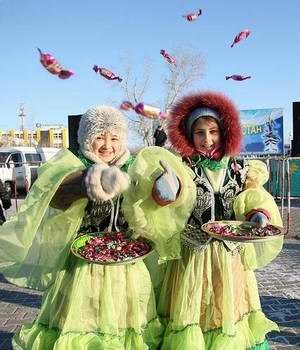
Have a nice spring! Shashu!
Lesson objectives:To understand traditions and customs of Kazakhs, respect and use in teaching English
Language: Core: yurt, ornament, dombra, kazakh hospitality, shildekhana, besikke salu, tsau kesu, sundetke otyrgyzu, kokpar, neke, kurban ait, beshbarmak, pilgrimage, Nauryz, shashu
Materials: Computer, interactive board, 11 cards or lists of paper with the text of kazakh traditions and customs and numbers on the other side, a plate of different kinds of sweets, cards with kazakh ornaments as a symbol for every participant
1. Here are 11 cards with the numbers, take any one, on the other side kazakh tradition or custom. You have 2-3 min. to explain all participants this tradition, also you can show a picture. 30-35 min.)
Yurt
Card 1
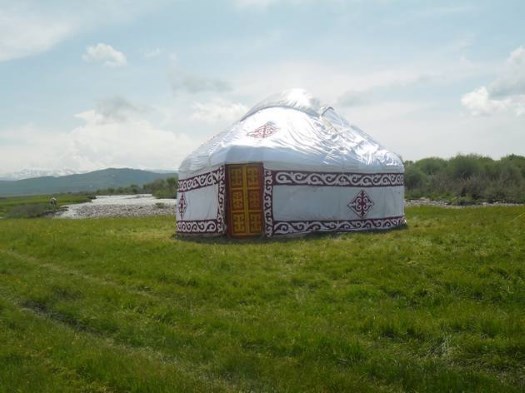
At one time, the nomadic Kazakhs lived in yurts (cone-shaped tents of white felt stretched over a framework of wooden poles). Yurts are light and easy to assemble, dismantle and carry around. Today yurts have lost their former importance and are only used as temporary dwellings of chabans (shepherds) at remote seasonal pastures.
Traditionally every guest is offered Kazakh cuisine at the dastarkhan (the low table) in a yurt.
The yurt is one of the most sensible types of movable house, it's round-shaped dwelling without corners. It is a comfortable and practical home, a door looking to the East, so morning sun enters the house as a rule, ideally suited to local conditions and ways of life - one of the greatest inventions of the Eurasian nomads. It is easily taken apart (it is said that a Kazakh woman can do it in half an hour) and carried by horses and camels. The yurt consists of three main elements: an extensible trellis base (the kerege), a dome made of poles (the uyk) and a round top (the shanyrak).

The yurts, in fact, have nowadays acquired a new look. They are covered with beautiful fabrics with national ornaments, have more rooms and are supplied with electricity from portable diesel-electric sets. Radio and television sets, portable gas stoves and other household appliances have become a common sight in Kazakhstan yurts.
So, you are flinging open the embroidered felt drapes that cover the entrance to the yurt. Everyone stands up at once, thus showing respect for the entering guest. You are greeted with a smile and a handshake and are shown to the tor - a place of honor where the guests are to be seated. Usually it is against the wall facing the entrance. Putting many questions to the visitor is considered bad manners in Kazakhstan. He should have a rest after his journey and is treated to drink of kumis, a fermented beverage made from mare’s milk, which is both refreshing and invigorating, and is served in a porcelain piala (teacup) or in a painted wooden cup or have traditional kazakh tea with milk.
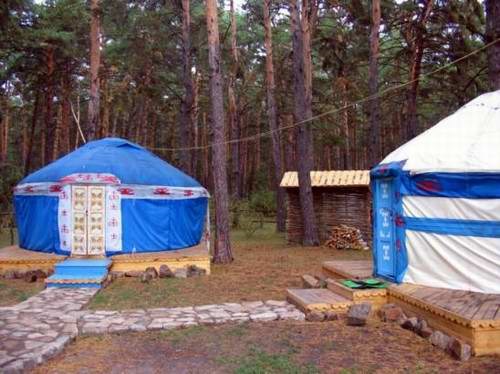
Dombra
Card 2

The Kazakhs love the art of wordplay and their akyns (poets), who improvise at public competitions (aitys) accompanied by Kazakh stringed musical instruments: the dombra or the kobyz. Great Kazakh composer Kurmangazy Sagyrbayev (1823-1896) is a well known dombra player, his famous melodies "Saryarka -Golden Steppe", "Adai", "Balbyraun" are about love to his Earth, his motherland and Kazakh people. Kazakhs say: "You are not real Kazakh, if you don't play dombra". So, every Kazakh should have dombra as a national musical instrument, as the symbol of love to music and creativity. You can hear amazing kazakh melodies and songs at all great national kazakh festivals, ceremonies, for example Nauryz holiday, Day of Independence, Day of the first President and other holidays.
Kazakh ornaments
Card 3
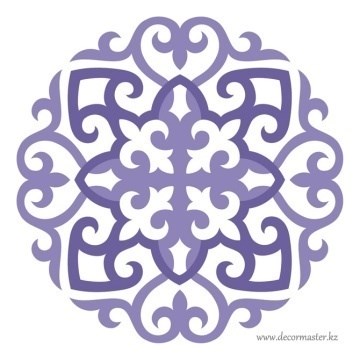
The spiritual nature of ornament as of the original genetic code in the traditional art of Central Asian nomads. The scientists consider it as a peculiar embodiment of the centuries-old philosophical conception of steppe's worldview basis merging the dualism of time and space. That would help to clear the specificity of nomadic thinking which has allowed ornament to overstep the bounds of pure artistic technique and to be transformed into a spiritual constant responsible for preservation and transfer of folk's creative potential.
There are four types of ornaments that are generally found in Kazakh dress, and these are: geometric (shapes), botanical (florals), cosmogonical (having to do with astronomy and astrophysics) and zoomorphic (inspired by animals). These ornaments were used heavily in the clothing of the traditional Kazakh people because there were not many other art forms available during their time.
Historically, the Kazakh people also had to use what was around them to create their clothing, and what people wore indicated their social status to others. Most clothing was made from felt, wool, fur, animal hides, and eventually, cotton. Wealthy folk had their clothing made out of silk, velvet, and brocade.

In addition to using materials that were readily available to them, the Kazakh people also used color in a specific way. The blue color represented the sky, the white color was a symbol for joy, yellow signified wisdom, red meant fire and the sun, green represented youth and spring, and black was symbolic for the ground.
If ornament is a language it should have a certain system and exist in system, like music or poetry, as “ornament is the art of system relations of visually perceived signs". One of the most important and peculiar its inherent qualities is the rhythm, the same as it is in “temporal arts”, music or poetry, although ornament itself has a spatial character. Thus, ornament possesses dual essence that harmoniously unites time and space
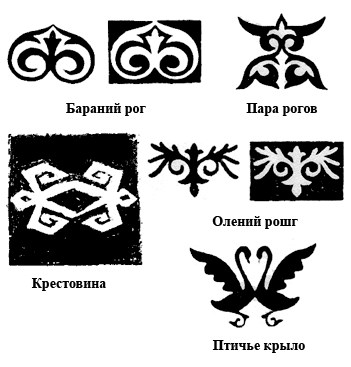
Today we can hardly understand once perfect system of traditional Great Steppes nomadic culture. Analyzing what acts as the protection of the spiritual kernel of any culture including the nomadic one, we can come to a conclusion that it is the ornament which has absorbed energy and aesthetics of the thousand-year sacred traditions. Admiring what we perceive as “ancient samples of national handicraft art”, we generally take it for just valuable factological material allowing us to penetrate deep into centuries. And the ornament that covers artifacts we regard as nothing else but an intricate pattern created by imagination of national craftsmen and forgetting, or most likely simply not understanding that we deal with a special type of symbolical texts, with a ligature which narrates the genesis and the flowering of the world believe that traditional ornament is not a pattern possessing only artistic value. Ornament correlates aesthetic uniqueness and specific world outlook, generated at the dawn of culture's genesis. Perhaps, ornament is the only witness remained in centuries and called to prove the deepness of the symbolical consciousness, created by the unity of a myth and a person.
By means of these codes ornament forms spiritually and visually the universal Model of the World. The symbols which have incorporated religious, secular, and universal formulas, allow ornament to become a sacred language. Throughout centuries ornament remains an integral part of celebratory and daily clothes of the Kazakh-nomad, a decoration of his weapon, dwelling, wedding and funeral ceremonies, i.e. it is something special that accompanies a person from birth to death or, to say it differently, it is a certain constant representing quintessence of culture's spiritual consciousness.
The specifics of nomadic way of life have caused the formation of a special word-view radically different from the settled one.
Ornament in Kazakh people language is named “oyu-ornek” (“oyu” - pattern, “ornek” - tracery). The master of making ornaments is called “oyushy”. Kazakh people respect oyushy very much.

Ornament is the eternally living language as it expresses topical absolute truth. A myth being ornament's basis is “a vital, subjective intercommunication comprising its own, extra-scientific, purely mythical validity, reliability, basic law and structure” [17, c. 58]. It is independent and is capable for the development.
It is necessary to mention the fact that in the conditions of growing spiritual discord at the turn of the 19th and the 20th centuries an increasing quantity of researches in the field of philosophy of culture, art and history in some way turn their investigations to ornament, to its genesis and essence, thereby confirming its status. Besides general theoretical questions the aim of searches was also to find that moment when art lost any spiritual support and was shaken for the first time perceiving itself “a colossus on clay legs”. Perhaps, no one but Spengler has investigated it so scrupulously and responsibly. He wrote that “any art is the expression's language” [14, c. 424], and as usual it does not demand any witness. But it is equitable for any art while “only a higher art decisively becomes “art in front of witnesses”, and particularly in front of the highest witness: God” [14, c. 425].
National kazakh food
Card 4
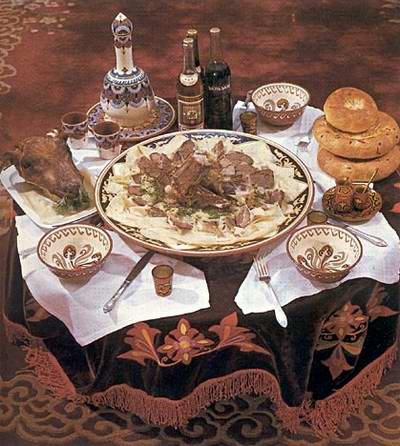
Mostly kazakh food is made from meat and milk, above all, delicacies made from horse meat such as:
- shuzhuk (sausage made of finely chopped meat);
- kazy (sausage from ribs);
- karta (sausage from the belly);
- zhaya (boiled rump);
- zhal (from urthers);
- steaming kuirdak (from lamb);
- zhaubuirek (a whole carcass of a ram broiled on a spit);
- syrbaz (a suckling lamb stewed in its own juice);
- beshbarmak (a dressed carcass of a ram or a foal boiled in a cauldron),
- baursak
- kumis

Kazy, karta, shuzhuk

Kuirdak
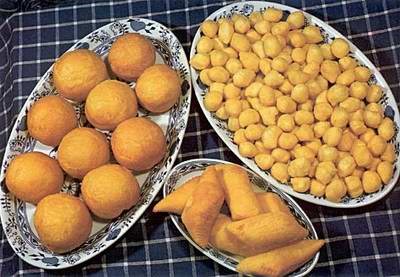
Baursaki
Kazakh hospitality
Card 5

There is an unofficial law voiced in ancient times, which says:
“Meet a guest as the God's messenger”
Hospitality is considered a sacred duty in the Kazakh society. At all times, the steppe inhabitants did their best to please their guest.
Respect for the elderly is another positive feature of Kazakhs. Traditionally, a child from early childhood is taught to be moderate and honest when dealing with older, wiser and life experienced people. However, the above mentioned national identities that served as a basis for the occurrence of generalized rules and principles of public relations (tradition), fortunately, are confined not only to representatives of the Kazakh people. Therefore, there are presented to your attention a list of basic and authentic customs, which are widespread in the Kazakh society.
Of course, the dastarkhan is a serious test of the hostess’ culinary talents. At the same time it is also an expression of the host’s cordiality and generosity. Often everyone in the neighbourhood who is noted for eloquence, singing or playing musical instruments is invited to such dinners.
“Why such a feast?” you may ask. The answer is: “You will never forget those with whom you once had a heart-to-heart talk at a good dastarkhan”.
Kazakhstan dastarkhan not only satisfies your thirst and hunger, it also lifts up your spirit. People learn much about one another at a dastarkhan. And the word “hospitality” means not only a heart meal accompanied by merrymaking and laughter: it means above all a cordial conversation with the guest.
Konakkade - a tradition under which a host has a right to ask a guest to sing a song or play a musical instrument (of course, as long as a guest is known for his or her talent), thus ensuring some fun and joy during the feast.
Erulik - if new settlers came to a village erulik was arranged in their honour, i.e. a small celebration that allowed newcomers to quickly adapt to the new location. Also, the custom erulik includes assistance in settling of the newcomers, when neighbours provide them with firewood, drinking water, etc. for the time being.
Toy dastarkhan is a special form of celebration, organized for holiday or during it. Sports competitions, music, singing competitions (aitys) and horse riding competitions are organised in addition to the gatherings during Toy dastarkhan.
Shildekhana, Besik toy, Tsau kesu
Card 6
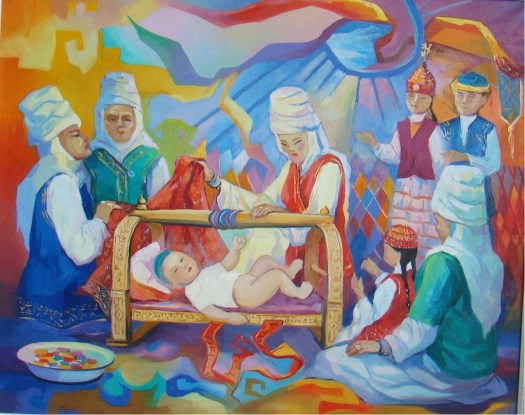
Бесікке салу Колыбель
Traditions, connected with the birth of children and their upbringing, apparently play a very important role in many cultures. Just a brief description of such traditions followed by Kazakh families, is given below. All of these traditions are usually followed by celebrations.
Shіldekhana - a celebration that is associated with childbirth. Usually all relatives and friends congratulate and help young parents, bring gifts for baby, a very warm and friendly atmosphere.
Besіkke salu, besik toy - a holiday, hosted when the newborn is put to a cradle - besik. As a rule, it is organized on the 3rd-5th day after dropout of umbilical cord of the kid.
Kyrkynan shygaru – a custom performed on the fortieth day after birth that includes bathing baby in 40 tablespoons of water, and the first haircut and nail cut. Celebration with relatives or friends.
Tsau kesu - Hobbles cutting
When a baby begins to walk, he undergoes another ancient rite- the hobbles cutting. A hobble of rope round a child’s legs is tied. It looks like a figure- of- eight. The child makes a few steps and the hobbles are cut with a scissors by the most respected guest. After cutting the hobbles the baby goes all his life more successfully, all the guests congratulate the baby with his first steps, give presents, celebrate this day.
Sundetke otyrgyzu is a rite of circumcision. This procedure can be in medical centers or hospitals, usually beforehand parents and an experienced surgery explains the boy about the importance in many muslim families to be healthy and stronger. The ceremony is held when a boy is 5-7 years old. All the relatives and friends are invited after this process for the ceremony. During Sundetke otyrgyzu guests usually congratulate and bring generous gifts to the hero of the occasion and his parents.
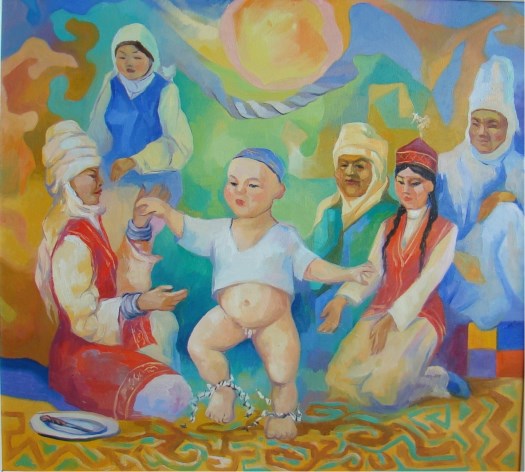
National game
Card 7
National games are usually performed on horseback and are an opportunity to witness the Kazakhs' outstanding riding skills. Kazaksha kures (Kazakh wrestling), baiga (horse racing over 25, 50 or 100 km), kokpar, kyz-kuu (catch the girl) and alty bakan (six-pole swing).
Kazakh national games took a great and important role in the life of the Kazakh people. It is known that they put people in good spirits, gave strength, agility and endurance. Most of these games have a competitive nature. Two groups of riders take a part in this game. There was a goat carcass (kokpar) at a distance of 50-60 steps from competitors. Who first picks the carcass up from the ground, the other horsemen had to take it. This struggle between the players continued until the evening. If two groups participate in kokpar, the winner is the team whose player reaches the finish line first. In this competition, horsemen demonstrated agility, strength, accuracy, ability to stay in the saddle. Kazakh national games are closely related to the art of the people. First of all, it is a tradition and heritage of the people. There were marked out many capable and talented people.
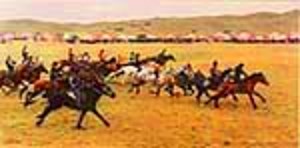
Nauryz
Card 8
Celebrating the Coming of Spring and Abundance
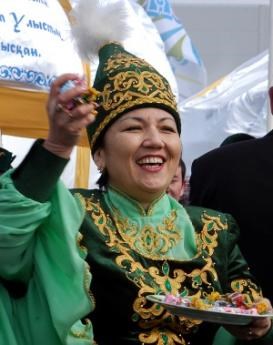
Nauryz is one of the oldest holidays on Earth. This holiday of spring and the renewed life of the Earth has been celebrated for over five thousand years by many cultures of the Middle and Central Asia. Historical records referring to this holiday can be found in ancient and middle age documents, it corresponds to Navruz, the Iranian New Year.
Two key traditional elements of Nauryz are feasting, starting with a tasty yogurt-like dish known as Nauryz kozhe, and the erecting of yurts, or traditional nomad homes.
The celebration was meant to reflect people's love to nature. People have preserved the tradition, and today the holiday has acquired new spiritual and ethical meaning. This holiday is celebrated on 21st – 23rd of March, the day of the spring equinox. That's why the Kazakhs call the month of March Nauryz. Nauryz as a non-religious celebration of the spring and renewal is closely linked to some other Kazakh holidays, such as a "farewell to winter" festival. Boys born on this day would be called Nauryz, Nauryzbai or Nauryzbek, and girls Nauryzgul.
Kazakhs called Nauryz the Day of the People or the Great Day of the People. People believed, the more generous the celebration of Nauryz was the happier the year would be. On the eve of the holiday, people would clean their homes.
During the day, everybody tried to be in good spirits, would give a big hug to each other and wish good fortune and happiness to others. People respecting this nearly month-long holiday forgive each others' debts and offences.
Kazakhs attached special importance to the number of seven during Nauryz celebrations because it symbolized the seven days of the week, which was considered to be a time unit of the universal eternity. Seven bowls with Nauryz-kozhe drink (made from seven ingredients) would be put in front of the aksakals (respectable old people). The meals were composed of seven components, usually meat, salt, fat, onions, wheat, kurt (a type of cheese) and irimshik (a kind of cottage cheese). These seven ingredients symbolize the seven virtues of joy, success, intelligence, health, wealth, agility and security.
Of course, the modern festival is essentially different from the old. The yurts act as focal points for people to find out more about the culture and lifestyle of the traditional nomads through Kazakh songs, dance and national clothing. More modern festivities such as firework displays and music concerts will also take place during Nauryz.
On 30 September, 2009, Nauryz (Novruz) was included into UNESCO’s List of the Intangible Cultural Heritage. On 23 February 2010, the United Nations declared March 21 the International Day of Nauryz (Novruz). It is dear to all the peoples living in the multinational Kazakhstan. The ancient holiday of Nauryz has naturally become a part of the modern life, preserving the old tradition.
Shashu is a custom (it is shown on the picture), when respectful woman shouts "Shashu" and throws sweets from plate to the people around, that means we all are glad to see you in this ceremony.
Kazakh wedding
Card 9
One of unique Kazakh traditions related to marriages is that the marriage between relatives up to the seventh generation is prohibited. Such taboo helps to prevent blood mixing and, consequently, benefit to the health of future offspring.
Traditionally, sequence of the ceremonies and rituals related to a marriage is the following.
Any wedding ceremony in the Kazakh society is anticipated by kudalyk (matchmaking). Before the wedding, matchmakers come to bride's house. Their task is to agree with the closest relatives of a girl on her marriage. During courtship, father of the bride receives gifts from the guests.
If negotiations are successful, the father presents a coat to the main matchmaker. This custom is called “Shege Shapa”. Preparation of "kuyruk bauyr" - a delicious dish from the liver and broad tail fat also testifies to the successful completion of courtship.
The next stage of the ceremony is send gifts of the bride Kyz uzatu. In the evening before the Kyz uzatu matchmakers come to the bride's house again. Early in the morning, the bride with matchmakers is sent to the groom's house.
Solemn ceremony of meeting the bride in the groom’s house is called kelіn tysіru. The main element of kelіn tysіru is a traditional performance of a song of instructions and wishes - Betashar or "opening of the face" (when bride should show her face covered by veil).
According to the tradition, the first threshold of the yurt was to be crossed by the bride, and be sure to do it with the right foot. Also during the wedding ceremony, the couple must drink together a bowl of water with dissolved sugar and salt, sometimes milk to be honest and happy.
The wedding in native Kazakh language is Uilenu toyi, the marriage is Ui bolu.
The religious part of the Kazakh wedding ceremony is called Neke Qiyu "Неке қию". The wedding process may take many weeks and even months to complete. Like marriages in most Muslim societies, involves a contract between families which requires negotiation. The Neke Qiyu is a small procedure, and usually takes about a half an hour to complete.
After she shows respect to her groom's family, the veil is lifted and the bride receives a kiss from her mother. The mother then puts a white scarf on her head to symbolize her marital status and then welcomes her into the groom's family.
Neke Qiyu is performed inside with close relatives only. The mullah and the couple sit facing one another. He briefly recites some verses from the Quran and asks the couple to confess the faith of Islam. When this ceremony is done, the couple must go and register their marriage at the state registry office.
Kurban Ait
Card 10
Kurban Ait
Card 10
Kurban-Ait is a peak of the universal humanistic traditions, it embodies high ideals of Islam and is the main holiday of all Muslims in the world. The holiday embodies care of the relatives and compassion to those in need. It is a tradition to wake up early, put on the best clothes, be friendly and visit parents, elders and sick relatives and remember the dead with the prayers.
Kazakhstan Muslims make every effort for further prospering of the country, development of our rich cultural and religious traditions, strengthening of inter-ethnic harmony and religious tolerance and mutual respect. The friendship, harmony and respect are our major pride and common heritage which we must preserve and praise Allah for it.
On the Kurban Ait day, Muslims visit mosques to comprehend the joy of the grand holiday. According to Shari'ah, the meat of the sacrificed animal is divided into three parts: two parts are given to the poor, orphans, and the needy, and the third is left for yourself, but if it is given to the poor, then it is welcomed by Shari'ah.
Everybody congratulates all Muslims on the holiday and wish happiness and prosperity.
Pilgrimage
Card 11
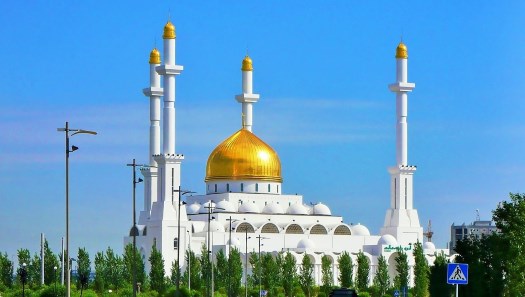
"The Great Steppe was something that gave to its inhabitants all which provided great religions. Moreover, it is something to be stronger than the world religions, evidenced by the victory, not only in war but also in the cultural aspects."
L. Gumilev
It is something L.Gumilev described in his book, according to most of the Kazakhs is undoubtedly sacred aruah (spirit) of ancestors of Kazakh people, such as Arystan Baba, Kozha Ahmed Yassaui, Becket ata and Ukash ata, Ablai Khan and Raiymbek batyr, Eset and Karasai batyrs, Jambyl, Kurmangazy and Abay ata, Aisha Bibi ana and Konyr aulie, and many, many others who had played and still play a huge role in the preservation and development of the Kazakh nationality, independence, identity and integrity.
Recent years the interest to this area and especially to sacred places was strongly increased on the part of people: the huge number of people every year make pilgrimages (during the weekend with good weather conditions to the sacred places of Becket-ata, located in the semi-desert area 250 km from Aktau , more than a thousand people a day come not only from all parts of the Republic of Kazakhstan, but also from other countries such as Russia, China, Great Britain, France and even Japan). It should be noted that in the holy places there have been many cases of miraculous healing people from different, sometimes incurable diseases, good life changes according to pilgrims words. There is no clear understanding of this phenomenon yet.
Sacred places in the territory of Kazakhstan are largely tied to the historical centers of the adoption and spread of Islam and are arranged according to the proverb of the Kazakh people " Otrarda - otyz bab, Mangystauda - Tomen bab, Sayramda- sansyz bab", which literally means "There 30 saints in Otrar ( the ancient capital of the Kazakhs), there are 1000 saints in Mangystau region (Western Kazakhstan, Pre-Caspian region with center in the Aktau city) – there are countless saints in Sayram- (Southern Kazakhstan, including the historical region of Turkestan, Kyzylorda and Shymkent cities). In fact, nearly to excavated from the sands ancient city Otrar there is a small number of sacred places, the main of which is the Arystan bab mausoleum, he is the man who brought Islam from Arabia to the vast territory of Kazakhstan. Mangystau and Atyrau regions, where for many years preached holy Shopan-ata and Becket-ata and their numerous followers, there are over thousands sacred places (according to the Kazakh people relation to these places). Finally, in Southern Kazakhstan, the historic area of Turkestan, where was founded famous Sufi school of great Kozha Ahmed Yassaui who was a direct disciple and successor of Arystan bab life-work. There are many and many sacred sites in this area. (For example, Kozha Ahmed Yassaui mausoleum presented by a big size building 46,5 x 65,5 meters and height of 44 meters).
Most of so called sacred places are related to houses, sites, areas and graves where the holy and saint people were lived or buried.
- Watch the video: https://youtu.be/oayNpputzWw and note national kazakh peculiarities
(dombra, national clothe, ornaments on the carpet, kazakh song about a dombra, a warm friendly atmosphere, respect to teachers). Draw in your notebook kazakh ornament.
- Which three languages do Kazakhs speak? (Kazakh, Russian, English)
- Which two large countries are the neighbors of Kazakhstan? (Russia and China)
- What does the word "kazakh" mean? (Free)
- Which nationalities live in Kazakhstan? ( Kazakhstan is multinational country, there are more than one hundred nationalities, mainly Kazakhs, Russians, Tatars, Uzbeks, Uigurs, Dungans, Chinese, Koreans, Caucasian peoples, Ukrainians, and many others). (10 min.)
Thank you very much for bringing nice spring and happy day!
And now kazakh tradition Shashu !
( A teacher takes a plate with sweets and throws around the participants, students and says Shashu! Lots of Love and Happiness! And gives all gifts-cards with kazakh ornaments)
https://www.youtube.com/watch?v=piMtC0v5LRc
You can download the PowerPoint from here
- https://www.youtube.com/watch?v=6ERbkViQzd0
- https://youtu.be/oayNpputzWw
- http://cyberleninka.ru/article/n/the-traditional-nomadic-ornament-as-a-spiritual-and-aesthetic- phenomenon#ixzz4ZL9XhVzw
- https://www.youtube.com/watch?v=piMtC0v5LRc (My country)
- https://www.youtube.com/watch?v=OB39_-qw77E (Nauryz celebration)
- www.dombra-music.kz



|